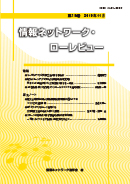Volume 21
Displaying 1-6 of 6 articles from this issue
- |<
- <
- 1
- >
- >|
ARTICLES
-
2022 Volume 21 Pages 1-13
Published: December 15, 2022
Released on J-STAGE: December 23, 2022
Download PDF (553K) -
2022 Volume 21 Pages 14-27
Published: December 15, 2022
Released on J-STAGE: December 23, 2022
Download PDF (542K) -
2022 Volume 21 Pages 28-47
Published: December 15, 2022
Released on J-STAGE: December 23, 2022
Download PDF (601K) -
2022 Volume 21 Pages 48-67
Published: December 15, 2022
Released on J-STAGE: December 23, 2022
Download PDF (582K)
NOTES
-
2022 Volume 21 Pages 68-88
Published: December 15, 2022
Released on J-STAGE: December 23, 2022
Download PDF (621K) -
2022 Volume 21 Pages 89-108
Published: December 15, 2022
Released on J-STAGE: December 23, 2022
Download PDF (578K)
- |<
- <
- 1
- >
- >|
